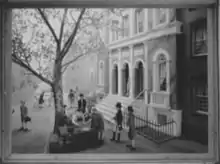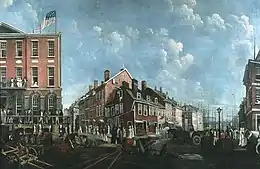

The Buttonwood Agreement is the founding document of what is now New York Stock Exchange and is one of the most important financial documents in U.S. history.[2] The agreement organized securities trading in New York City and was signed on May 17, 1792 between 24 stockbrokers outside of 68 Wall Street. According to legend the signing took place under a buttonwood tree where their earliest transactions had occurred.[3] The New York Stock Exchange celebrates the signing of this agreement on May 17, 1792 as its founding.[2]
History
In March 1792, twenty-four of New York's leading merchants met secretly at Corre's Hotel to discuss ways to bring order to the securities business. Two months later, on May 17, 1792, these men signed a document called the Buttonwood Agreement, named after their traditional meeting place under a buttonwood tree – not because it was signed there.[3]
There were too many brokers involved to meet under a tree. Business was conducted in various offices and coffee houses. In 1793, they coordinated their business inside the Tontine Coffee House on the corner of Wall and Water streets.[4]
The document is now part of the archival collection of the New York Stock Exchange.[5]
Document agreement
In brief, the agreement had two provisions: 1) the brokers were to deal only with each other, thereby eliminating the auctioneers, and 2) the commissions were to be 0.25%. It reads as follows:
We the Subscribers, Brokers for the Purchase and Sale of the Public Stock, do hereby solemnly promise and pledge ourselves to each other, that we will not buy or sell from this day for any person whatsoever, any kind of Public Stock, at a less rate than one quarter percent Commission on the Specie value and that we will give preference to each other in our Negotiations. In Testimony whereof we have set our hands this 17th day of May at New York, 1792.[4]
Signers
The twenty-four brokers, known as Founding and Subsequent Fathers, who signed the Buttonwood Agreement were (including business location):[6]
- Peter Anspach … 3 Great Dock Street
- Armstrong & Barnewall … 58 Broad Street
- Andrew D. Barclay … 136 Pearl Street
- Samuel Beebe … 21 Nassau Street
- G. N. Bleecker … 21 Broad Street
- Leonard Bleecker … 16 Wall Street
- John Bush … 195 Water Street
- John Ferrers … 205 Water Street
- Isaac M. Gomez … 32 Maiden Lane
- Bernard Hart … 55 Broad Street
- John A. Hardenbrook … 24 Nassau Street
- Ephraim Hart … 74 Broadway
- John Henry … 13 Duke Street
- Augustine H. Lawrence … 132 Water Street
- Samuel March … 243 Queen Street
- Charles McEvers Jr. … 194 Water Street
- Julian McEvers … 140 Greenwich Street
- David Reedy … 58 Wall Street
- Robinson & Hartshorne … 198 Queen Street
- Benjamin Seixas … 8 Hanover Square
- Hugh Smith … Tontine Coffee House
- Lutton & Hardy … 20 Wall Street
- Benjamin Winthrop … 2 Great Dock Street
- Alexander Zuntz … 97 Broad Street
References
- ↑ Hewitt, p. 31
- 1 2 Pisani, Bob (17 May 2017). "This single-paged document started the New York Stock Exchange 225 years ago". CNBC. Retrieved 7 April 2020.
- 1 2 Banner, Stuart (January 1998). "The Origin of the New York Stock Exchange, 1791–1860". The Journal of Legal Studies. The University of Chicago Press. 27 (1): 113–140. doi:10.1086/468015. JSTOR 10.1086/468015.
- 1 2 Teweles, Richard Jack; Bradley, Edward S.; Teweles, Ted M. (25 September 1992). The Stock Market (6th ed.). Wiley. p. 97. ISBN 9780471540199.
- ↑ Durante, Dianne L. (22 June 2016). "New York Stock Exchange: 224 Years and Counting". Dianne Durante Writer. Retrieved 16 August 2014.
- ↑ Wyckoff, Peter (1972). Wall Street and the stock markets: A chronology (1644–1971). Chilton Book Co. p. 145. ISBN 0-8019-5708-7.
External links
- Image of agreement at the Virtual Museum and Archive of the History of Financial Regulation of The Securities and Exchange Commission Historical Society
- Video of agreement as part of story on the CNBC cable network.